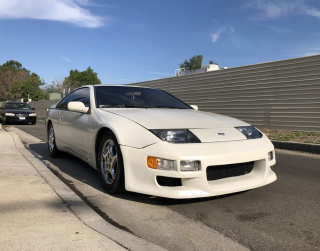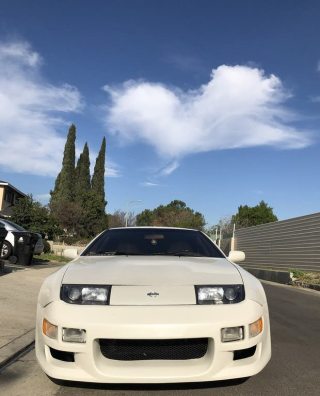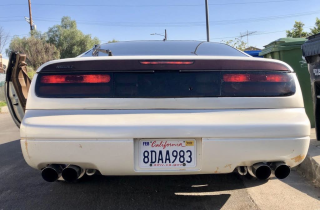The Good
The 1993 300ZX boasts a stunning, enduring design that appeals emotionally, alongside exhilarating Twin Turbo performance and engaging handling. For practical buyers, it offers a surprisingly comfortable ride for a sports car, T-top versatility, and solid build quality. While not fuel-efficient by modern standards, the NA models offer reasonable economy for their class, and well-maintained examples hold increasing collector value.
The Bad
Known weaknesses include its complex engine bay, leading to expensive and difficult maintenance, especially for Twin Turbo models. Aging electronics can cause gremlins, and rubber components deteriorate over time. Watch out for oil leaks, turbocharger wear, HICAS issues on TT models, and the critical, costly timing belt service. Deferred maintenance is a major red flag for this vehicle.
1993 Nissan 300ZX: Quick Overview
- Engine Options:
- 3.0L DOHC VG30DE V6 (Naturally Aspirated - NA)
- 3.0L DOHC VG30DETT V6 (Twin Turbocharged - TT) - Horsepower:
- NA: 222 hp at 6400 rpm and 198 lb-ft of torque at 4800 rpm
- TT: 300 hp at 6400 rpm and 283 lb-ft of torque at 3600 rpm (US market, Japanese market was 280 hp due to "gentleman's agreement") - Fuel Economy (EPA estimates, vary with transmission/driving style):
- NA: Approximately 18-22 MPG combined
- TT: Approximately 17-21 MPG combined (requires premium fuel) - 0-60 MPH Times (approximate, depending on source/condition):
- NA: 6.5-7.0 seconds
- TT: 5.0-5.5 seconds - Towing Capacity:
- Not applicable; the 300ZX is a high-performance sports car and not rated for towing. - Trim-Level Features:
- NA (Naturally Aspirated): Generally offered as a 2+2 (four-seater) with T-tops as standard or an occasional hardtop 2-seater. Standard features included power windows, locks, and mirrors, automatic climate control, cruise control, a tilt steering wheel, and cloth upholstery. Optional features often included leather seats and a premium Bose sound system. ABS was optional.
- TT (Twin Turbo): Primarily a 2-seater (some rare 2+2 TT models exist) with T-tops. Built on the NA's features, it added significant performance upgrades such as standard Nissan's HICAS 4-wheel steering system, larger sport brakes, a stiffer suspension, and wider wheels/tires. Leather upholstery and power-adjustable seats were often standard or common options. ABS was standard. Exterior differences included a more aggressive front fascia and a rear spoiler. Both trims featured advanced digital automatic climate control and a distinctive '90s cockpit design.
1993 Nissan 300ZX Specifications
Vehicle Information
| Year | 1993 |
| Make | Nissan |
| Model | 300ZX |
| Trim | - |
| Style | Coupe |
| Type | Coupe |
| Category | Sports Car |
Manufacturing Details
| Made In | Japan |
| Manufacturing City | KYOTO CITY |
Dimensions
| Doors | 2-Door |
| Curb Weight | 3449 pounds |
| Gross Vehicle Weight Rating | - |
| Overall Height | 48.30 inches |
| Overall Length | 169.50 inches |
| Overall Width | 70.50 inches |
| Wheelbase Length | 96.50 inches |
| Standard Seating | 2 |
Engine & Performance
| Engine | 3.0-L V-6 DOHC 24V |
| Engine Size | 3L |
| Engine Cylinders | 6 |
| Transmission | 5-Speed Manual |
| Transmission Type | Manual |
| Transmission Speeds | 5-Speed |
| Drivetrain | Rear-Wheel Drive |
Additional Features
| Anti-Brake System | 4-Wheel ABS |
| Steering Type | Rack & Pinion |
Pricing
| Manufacturer Suggested Retail Price (MSRP) | $30,900 |
| Invoice Price | - |
| Delivery Charges | - |
Vehicle History Report
Specifications
History
Events
History Check
Check
Check
Check
Check
Listings
Recalls
Check
Analysis
What Problems Does the 1993 Nissan 300ZX Have?
Specific engine-related issues include: faulty fuel injectors, particularly the "green connector" type used up to 1994, which can lead to misfires or even engine fires. Oil leaks from valve covers, timing belt covers, and the rear main seal are common due to aging gaskets and seals. The timing belt service is critical and expensive, required every 60,000 miles, and often neglected, leading to catastrophic engine failure if it breaks. Twin Turbo models are prone to turbocharger wear or failure, especially if oil changes are skipped or the turbos are not properly cooled down. EGR (Exhaust Gas Recirculation) system issues are also common.
Electrically, owners often face alternator failures, climate control display malfunctions (fading LCD), power antenna issues, and aging wiring harnesses leading to various gremlins. The premium Bose sound system is known for its amplifiers failing due to age.
For Twin Turbo models, the HICAS (High Capacity Actively Controlled Steering) 4-wheel steering system, while innovative, can develop leaks or outright failure, often leading owners to install lockout kits. Suspension bushings and steering rack leaks are also common.
Other common problems include T-top leaks, aging brake master cylinders, and clutch hydraulic issues (master/slave cylinders). Rust can be a concern in northern climates, affecting subframes, rocker panels, and suspension components.
Regarding recalls, the Z32 generation had several. For the 1993 model year, specific recalls included certain fuel hose replacements to prevent leaks (NHTSA Campaign ID: 94V027000, 94V028000) and brake booster issues (NHTSA Campaign ID: 93V140000) affecting power assist, which should be checked for completion when considering purchase.
How long will the 1993 Nissan 300ZX last?
However, weaknesses emerge over time. Rubber components like bushings, hoses, and seals invariably degrade, leading to leaks, rattles, and less precise handling. Electrical systems become fragile, with wiring harnesses potentially becoming brittle, causing intermittent faults. Turbochargers on TT models have a finite lifespan. Rust, particularly in subframes, suspension mounting points, and rocker panels, can compromise structural integrity in areas exposed to road salt. The car's complexity means specialized parts can become difficult to find or "No Longer Available" (NLA), impacting long-term repairability. Consistent, preventative maintenance is crucial for longevity, otherwise, it can quickly become a money pit.
What Technology & Safety Features are Included?
Built-in Tech & Comfort: Standard amenities across both NA and TT models included power windows, power door locks, power adjustable mirrors, and a fully automatic digital climate control system that was quite sophisticated for its time. Cruise control was also standard. The driver's cockpit was ergonomically designed, with controls angled towards the driver, emphasizing a sports-car-focused experience.
Entertainment: The standard entertainment system featured an AM/FM radio with a cassette player. A highly sought-after optional upgrade was the Nissan/Bose premium sound system, which delivered impressive audio quality through custom-tuned speakers and an integrated amplifier. An optional CD player or trunk-mounted CD changer was also available, offering a cutting-edge music experience for the period.
Driver-Assistance: A standout driver-assistance feature for the Twin Turbo model was Nissan's HICAS (High Capacity Actively Controlled Steering) 4-wheel steering system. This system dynamically adjusted the rear wheel angle at higher speeds to improve handling and stability during cornering. Anti-lock Braking System (ABS) was standard on the Twin Turbo and an available option on the Naturally Aspirated models, significantly enhancing braking performance and safety.
Safety Features: For 1993, the 300ZX came standard with a driver's side airbag, which was becoming more common but not universal. Three-point seatbelts were standard for all occupants. The vehicle also incorporated side-impact door beams for enhanced passenger protection. While specific crash-test ratings in modern formats (like NHTSA star ratings or IIHS awards) are not available for vehicles of this vintage, the 300ZX was designed to meet and often exceed contemporary safety standards of the early 1990s, offering a respectable level of protection for its time. It featured a rigid unibody construction, contributing to its overall passive safety.
What Colors Options are Available?
1993 Nissan 300ZX Prices and Market Value
Like most new cars, the 300ZX experienced substantial depreciation in its initial years. However, in the current used market, prices are highly variable and have seen a significant upswing, especially for well-preserved examples. A project car might be found for $5,000-$10,000, while a good driver-quality model can fetch $15,000-$25,000. Pristine, low-mileage Twin Turbo models with comprehensive service records are increasingly becoming collector's items, often selling for $30,000-$60,000 or even higher at auction.
Factors heavily affecting resale value include the vehicle's overall condition (exterior, interior, mechanical), documented maintenance history, mileage (lower is better for collectors), trim level (Twin Turbo models consistently command higher prices), and transmission type (manuals are generally more desirable). Originality also plays a major role; heavily modified examples may appeal to a smaller audience, often at a lower premium unless professionally done.
1993 Nissan 300ZX Cost of Ownership
1993 Nissan 300ZX Fuel Efficiency
1993 Nissan 300ZX Safety Rating
NHTSA
IIHS
1993 Nissan 300ZX Warranty
Basic
Powertrain
Rust
1993 Nissan 300ZX Insurance
reasonable repair costs.
How Does the 1993 Nissan 300ZX Compare to Other Coupe?
Performance: The 300ZX Twin Turbo (300 hp) was a performance powerhouse, directly competitive with the Supra Twin Turbo (320 hp), RX-7 (255 hp), and 3000GT VR-4 (300 hp). It offered exceptional handling thanks to its sophisticated suspension and available HICAS 4-wheel steering. While the Supra TT often gets the edge for sheer straight-line speed and tuning potential, the 300ZX TT was lauded for its balanced grand touring capabilities. The Naturally Aspirated 300ZX (222 hp) was a strong performer in its own right, competing with the Supra NA (220 hp) and base 3000GT (222 hp).
Features: The 300ZX was arguably the most technologically advanced and luxurious of the Japanese rivals, featuring digital climate control, optional Bose audio, and the innovative HICAS. The 3000GT VR-4 also packed tech like active aero and electronically controlled suspension, but often felt heavier. The Supra and RX-7, while equally capable, were generally more spartan and driver-focused inside.
Reliability: For a complex sports car, the 300ZX has a decent reputation for reliability if meticulously maintained. However, it's less bulletproof than the legendary Supra MK4 NA. The RX-7, with its rotary engine, is notoriously maintenance-intensive and prone to apex seal failure without proper care. The 3000GT VR-4 shared similar complexity and potential issues with the 300ZX TT due to twin turbos and AWD.
Price (New): All these rivals were premium-priced sports cars, with the Twin Turbo models often starting in the $40,000+ range, making them aspirational vehicles.
Alternatives & Recommendations:
- Better (depending on criteria): For ultimate reliability and tuning potential, the Toyota Supra MK4 Twin Turbo is arguably superior, though current market values are significantly higher. If budget allows for a higher tier, the Acura NSX offers supercar performance with Honda reliability.
- Similar: The Mitsubishi 3000GT VR-4 offers a similar blend of performance and technology with its AWD and active aero, but is heavier. The Mazda RX-7 FD is a more raw, lightweight, and engaging drive, but requires a dedicated owner willing to maintain its rotary engine.
Final Verdict: Is the 1993 Nissan 300ZX a Good Coupe?
Is it worth buying? Absolutely, but with crucial conditions. Only consider buying a used example, as it's now a classic. Focus on the best-maintained example you can find, preferably with extensive service records to prove diligent care. Avoid "bargain" project cars unless you have the skills, time, and deep pockets for a full restoration, as deferred maintenance can lead to astronomical repair costs. While the Twin Turbo offers superior performance and collector appeal, the Naturally Aspirated model is a more reliable and economical choice for a daily driver or entry-level enthusiast. Be prepared for higher ongoing ownership costs compared to a modern vehicle. For the right buyer, it's a highly rewarding and stylish classic sports car.



